Search
Search for "click":
(Click here to search this entire website for "click" with Google.)
 |
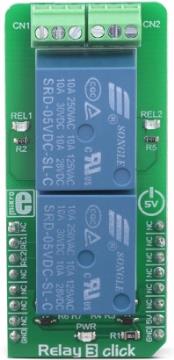
|
|
Relay click 3 is a dual relay Click board, featuring two single-pole double-throw relays which can be operated by output pins of the host microcontroller (MCU). It offers an elegant and easy solution for controlling a wide range of power applications. Two SRD-5VDC-SL-C relays used on this Click board™ are hermetically sealed relays which require 5V across their coils while consuming about 0.4W while active. They allow up to 28VDC across the connected load, while conducting up to 7A. Relay 3 click can be used in various PLC-based systems, as a remote ON/OFF switch, and other similar applications.
Relay click 3 is supported by a mikroSDK compliant library, which includes functions that simplify software development. This Click board™ comes as a fully tested product, ready to be used on a system equipped with the mikroBUS™ socket.
|
|
|
|
 |
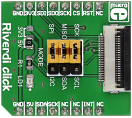
|
|
Riverdi click is a simple adapter for connecting Riverdi TFT displays to a mikroBUS socket. It features a zif20 connector for interfacing between your target board microcontroller and a FT8xx graphic controller on one of the many available Riverdi displays. A set of onboard jumpers allow you to switch between I2C and SPI communication lines. This simple click also has standard click board SMD jumpers for switching between a 3.3V and a 5V power supply. Browse the selection of over 20 available displays that come in different sizes, with touchscreen options, as well as several framing options. A 20-way ribbon cable, for connecting to the Riverdi display, is included in the package. |
|
|
|
 |

|
|
The RS232 communication standard is established back in the ‘60s, but thanks to its implementation on a wide range of devices - including PC motherboards, it gained a lot of popularity and it is still in use. Over time, this standard went through many revisions and the most recent revision is TIA-232-F (R2012). Although it was originally developed to connect teletypewriters and modems, nowadays it is used for serial communication between a wide array of different devices.
To implement the RS232 communication standard on the MCUs, it is necessary to convert the voltage levels to the levels acceptable for the modern MCUs. RS232 2 click performs full RS232 to UART signal conversion, allowing both 3.3V and 5V operation. Additionally, it features ±15 kV ESD protection for the RS-232 I/O pins. These attributes make this click a perfect solution for battery powered, hand-held and portable equipment, PDAs, palmtops, digital cameras, and other devices that still support the RS232 standard. |
|
|
|
 |

|
|
RS485 2 click carries the MAX3471 half-duplex transceiver intended for lithium battery-powered RS-485/RS-422 applications.
The click is designed to run on either 3.3V or 5V power supply. It communicates with the target microcontroller over UART interface with additional functionality provided by the following pins on the mikroBUS™ line: PWM, CS. |
|
|
|
 |
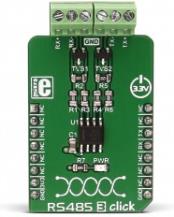
|
|
RS485 3 click uses SN65HVD31DR from Texas Instruments, a tri-state differential line driver and differential input line receiver. The click is intended to be used as UART to RS422/RS485 communication interface. It is suited for transmitting smaller blocks of data over long distances, using the four-wire bus, allowing for full-duplex communication.
It can be used as a transceiver between UART interface and RS422/RS485 communication bus. RS485 3 click can be used for controlling various building automation systems, light controllers, sensors and many small embedded devices that can all share the same bus, which can stretch up to 254 nodes and up to 1200m in length. |
|
|
|
 |
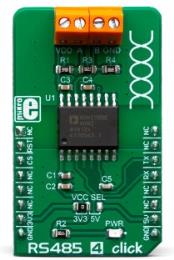
|
|
RS485 4 Click offers an UART to RS485 signal conversion, featuring the ADM2795E specialized IC with the complete galvanic isolation. Digital input and output signals are transmitted across the isolation barrier by using the ICoupler®, an IC scale transformer technology, which allows signals to be magnetically coupled across the isolation barrier within the IC, providing galvanic isolation for up to 5KV and data transfer rates up to 2.5Mbps. The ADM2795E is designed as a very robust and reliable UART to RS485 transceiver, allowing it to be used in very harsh industrial or other noisy environments.
RS485 4 Click is supported by a mikroSDK compliant library, which includes functions that simplify software development. This Click board™ comes as a fully tested product, ready to be used on a system equipped with the mikroBUS™ socket.
|
|
|
|
 |

|
|
RS485 6 Click offers a half-duplex RS-485 communication with integrated surge protection, which can be used as an interface between the TTL level UART and the RS485 communication bus. It is based on THVD1429DT, a transceiver from Texas Instruments with signaling rate of up to 20 Mbps. This device features a wide common-mode voltage range from 3.3V to 5V, which makes it suitable for multi-point applications over long cable runs and noisy areas thanks to the integrated transient voltage suppressor (TVS) diodes in. This device and type of network is perfectly suitable for wireless infrastructure, building automation, HVAC systems or factory automation, and many more.
RS485 6 Click is supported by a mikroSDK compliant library, which includes functions that simplify software development. This Click board™ comes as a fully tested product, ready to be used on a system equipped with the mikroBUS™ socket.
|
|
|
|
 |
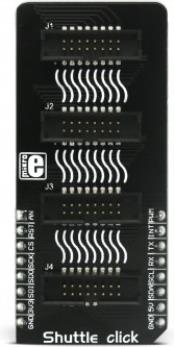
|
|
One click board™, numerous possibilities
Shuttle click is a mikroBUS™ socket expansion board, which provides an easy and elegant solution for stacking up to four click boards™ on a single mikroBUS™. It is a perfect solution for expanding the capacity of the development system with additional mikroBUS™ sockets when there is a demand for using more click boards™ than the used development system is able to support.
Shuttle click can be especially interesting for the development systems that are equipped with a very small number of mikroBUS™ slots, such as the Clicker family of development systems. Using Shuttle click on such system will greatly improve its usability by adding more mikroBUS™ sockets, yet it will remain small, compact and manageable. |
|
|
|
 |

|
|
Skywire™ click is an adapter click, which hosts NimbeLink/Skywire™ cellular modems (using stacking headers) to MikroElektronika development boards. It carries the MCP1826 low dropout regulator from Microchip.
Skywire modem not included. |
|
|
|
 |

|
|
The SpeakUp click is a speaker dependent speech recognition accessory board, which also has the ability to run standalone (no external microcontroller needed). It can be programmed to recognize over 200 different voice commands, which the onboard STM32F415RG MCU can react to. It works by matching sounds with pre-recorded commands. The firmware is based on the DTW speech recognition alghoritm, which enables fast operation with instant recognition. Sound is received through an onboard microphone and then processed by a VS1053 IC with a built in stereo-audio codec. The SpeakUp comes with a dedicated software tool for easy configuration. The board is lined with 12 user programmable GPIOs for standalone functionality, and can also be connected to a mikroBUS host socket, with communcation via SPI, I2C or UART.
|
|
|
|
 |
|
<< First
< Previous
Next >
|
|

